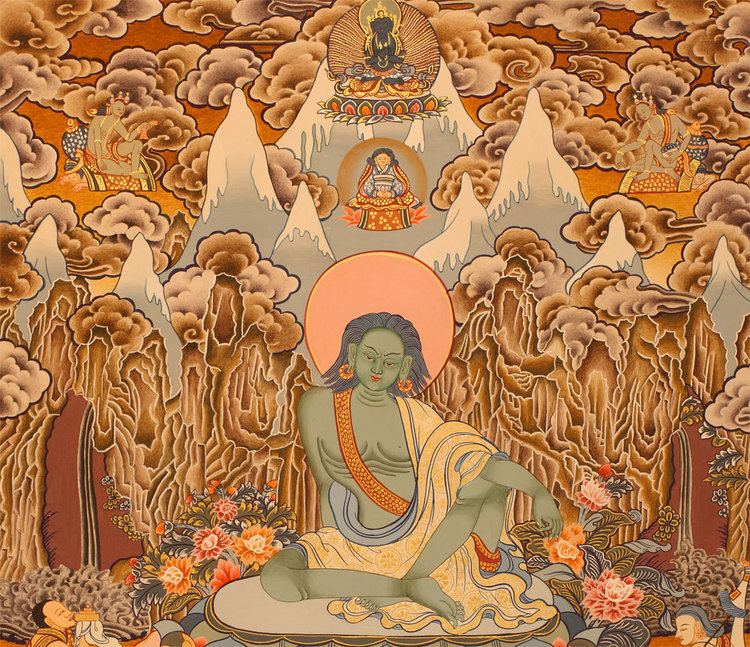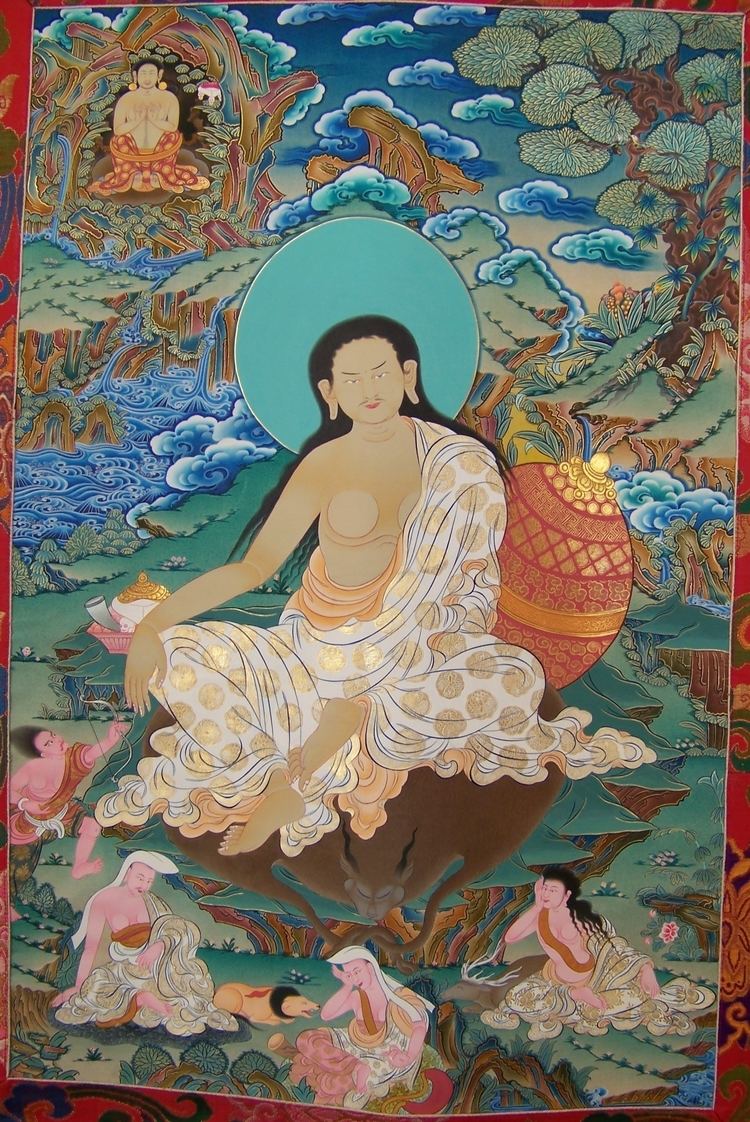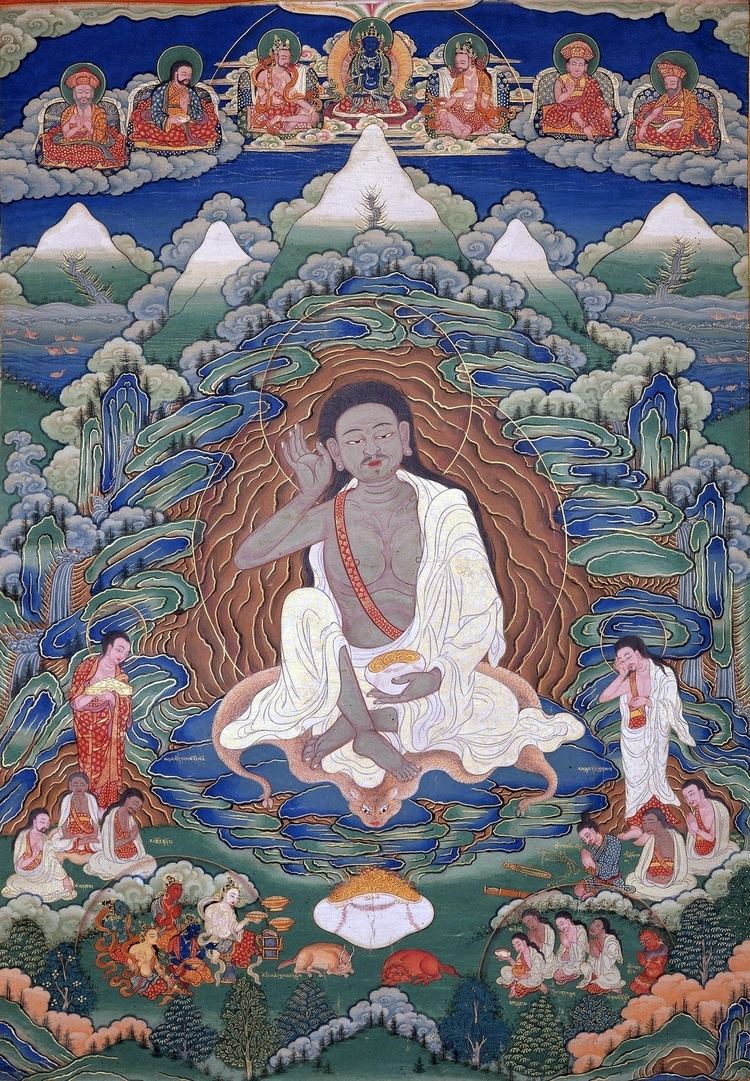Role Poet Died 1135 | Name UJetsun Milarepa | |
 | ||
Books hundred thousand songs of Milarepa Similar People Marpa Lotsawa, Gampopa, Naropa, Tilopa, Gautama Buddha | ||
Tipa yarkyi 2010 milai dzenam life of milarepa tibetan stage play
UJetsun Milarepa (Tibetan: རྗེ་བཙུན་མི་ལ་རས་པ, Wylie: rje btsun mi la ras pa) (c. 1052 – c. 1135 CE) is generally considered one of Tibet's most famous yogis and poets. He was a student of Marpa Lotsawa, and a major figure in the history of the Kagyu school of Tibetan Buddhism.
Contents
- Tipa yarkyi 2010 milai dzenam life of milarepa tibetan stage play
- Milarepa The Song Of The Madman
- Early life
- Sorcery
- Supernatural running
- Tutelage under Marpa
- Monastery
- Lineage
- References

Milarepa - The Song Of The Madman
Early life

Born in the village of Kya Ngatsa – also known as Tsa – in Gungthang, a province of western Tibet, to a prosperous family, he was named Mila Thöpaga (Thos-pa-dga'), which means "A joy to hear." His family name, Josay, indicates noble descent, a sept of the Khyungpo or eagle clan.
Sorcery

When his father died, Milarepa's uncle and aunt took all of the family's wealth. At his mother's request, Milarepa left home and studied sorcery. While his aunt and uncle were having a party to celebrate the impending marriage of their son, he took his revenge by summoning a giant hailstorm to demolish their house, killing 35 people, although the uncle and aunt are supposed to have survived. The villagers were angry and set off to look for Milarepa, but his mother got word to him, and he sent a hailstorm to destroy their crops.

Many of Milarepa's deeds took place in the homeland of Chö kyi Drönma, the Samding Dorje Phagmo, and his life and songs were compiled by Tsangnyön Heruka, sponsored by her brother, the Gungthang king Thri Namgyal De.

Milarepa later lamented his evil ways in his older years in conversation with Rechungpa: "In my youth I committed black deeds. In maturity I practised innocence. Now, released from both good and evil, I have destroyed the root of karmic action and shall have no reason for action in the future. To say more than this would only cause weeping and laughter. What good would it do to tell you? I am an old man. Leave me in peace."
Supernatural running

According to the book Magic and Mystery in Tibet by French explorer Alexandra David-Néel, Milarepa boasted of having "crossed in a few days, a distance which, before his training in black magic, had taken him more than a month. He ascribes his gift to the clever control of 'internal air'." David-Néel comments "that at the house of the lama who taught him black magic there lived a trapa [monk] who was fleeter than a horse" using the same skill. After witnessing such a monk David-Néel described how:
He seemed to lift himself from the ground.. His steps had the regularity of a pendulum ... the traveller seemed to be in a trance.
This esoteric skill, which is known as Lung-gom-pa in Tibet, is said to allow a practitioner to run at an extraordinary speed for days without stopping. This technique could be compared to that practised by the Kaihōgyō monks of Mount Hiei and by practitioners of Shugendō, Japan.
Tutelage under Marpa
Knowing that his revenge was wrong, Milarepa (then known by his boyhood name 'Fortuitous') set out to find a lama and was led to Marpa the Translator. Marpa proved a hard taskmaster. Before Marpa would teach Milarepa he had him build and then demolish three towers in turn. Milarepa was asked to build one final multi-story tower by Marpa at Lhodrag: this 11th century tower still stands. When Marpa still refused to teach Milarepa, he went to Marpa's wife, who took pity on him. She forged a letter of introduction to another teacher, Lama Ngogdun Chudor, under whose tutelage he practiced meditation. However, when he was making no progress, he confessed the forgery and Ngogdun Chudor said that it was vain to hope for spiritual growth without the guru Marpa's approval.
Milarepa returned to Marpa, and was finally shown the spiritual teachings. Milarepa then left on his own, and after protracted diligence for 12 years he attained the state of Vajradhara (complete enlightenment). He then became known as Milarepa. 'Mila' is Tibetan for; 'great man', and 'repa' means; 'cotton clad one.' At the age of 45, he started to practice at Drakar Taso (White Rock Horse Tooth) cave – "Milarepa's Cave", as well as becoming a wandering teacher. Here, he subsisted on nettle tea, leading his skin to turn green with a waxy covering, hence the greenish color he is often depicted as having, in paintings and sculpture.
Monastery
Nyanang Phelgyeling Monastery, also known as Sonam Gompa later in Nepal, which later became very famous in Nepal, is a Tibetan Buddhist monastery in a tiny village called Nyanang in Tibet near the border of Nepal. Fortunately Nyanang Phelgyeling Monastery has the rare statue of Milerapa which was created by his own disciple (Bhu Rechung Pa ). The statue was created in the lifetime of Milarepa. The cave is consecrated to Milarepa. It is built around the cave where he once lived. "It was destroyed but has now been rebuilt and decorated by Nepali artisans. This is one of many caves associated with Milarepa between Langtang and Jomolungma."
Lineage
Milarepa's lama was Marpa Lotsāwa, whose guru was Naropa, whose guru in turn was Tilopa. Milarepa is famous for many of his songs and poems, in which he expresses the profundity of his realization of the dharma. His songs were impulsive, not contrived or written down, and came about while he was immersed in enlightened states of consciousness.
Milarepa's life represented the ideal bodhisattva, and is a testament to the unity and interdependency of all Buddhist teachings – Theravada, Mahayana and Vajrayana. He showed that poverty is not a deprivation, but rather a component of emancipating oneself from the constrictions of material possessions; that Tantric practice entails discipline and steadfast perseverance; that without resolute renunciation and uncompromising discipline, as Gautama Buddha Himself stressed, all the sublime ideas and dazzling images depicted in Mahayana and Tantric Buddhism are no better than magnificent illusions. He also had many disciples, male and female, including Rechung Dorje Drakpa and Gampopa His female disciples include Rechungma, Padarbum, Sahle Aui and Tsheringma. It was Gampopa who became Milarepa's spiritual successor, continued his lineage, and became one of the main lineage masters in Milarepa's tradition.
